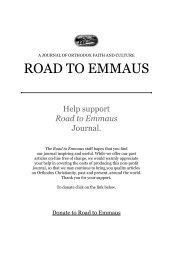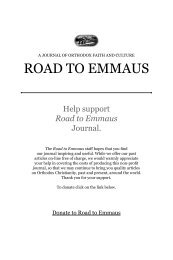RTE No 20 Interior - Road to Emmaus Journal
RTE No 20 Interior - Road to Emmaus Journal
RTE No 20 Interior - Road to Emmaus Journal
Create successful ePaper yourself
Turn your PDF publications into a flip-book with our unique Google optimized e-Paper software.
<strong>Road</strong> <strong>to</strong> <strong>Emmaus</strong> Vol. V, <strong>No</strong>. 4 (#19)Matthew) in the land of the Anthropofagai” and the “Acts of Peter andAndrew” are the work of Leucius Charinus. On the contrary, most scholarsaccept that these texts are the work of an unknown Coptic monk (with thenational, not the religious meaning of Coptic, because this was the pre-Chalcedonian period). This author could have been a gnostic heretic orequally, he could have been an Orthodox ascetic of the desert. We don’thave enough evidence <strong>to</strong> support either view.Both the great church his<strong>to</strong>rian Eusebius of Caesarea and St. Epiphaniusof Salamis 5 also condemned the “Acts of Andrew,” but not “The Acts ofAndrew and Matthias (Matthew) in the Land of Anthropofagi” and the “Actsof Peter and Andrew.” As far as we know, they didn’t even refer <strong>to</strong> these texts.The reason I am even considering material that was originally from thiscondemned text is that in the sixth century St. Gregory of Tours corrected theheretical points in “The Acts of Andrew” by Charinus, publishing a revisedtext with the name “Vita and Patio” (Life and Passion of Saint Andrew,)”which has been generally approved by the Holy Orthodox Church (parts of itappearing in hymns and services, and in the Synaxarion) as a basis for theLife of Saint Andrew. In this revision, St. Gregory of Tours accepts thatApostle Andrew preached <strong>to</strong> the Anthropofagai in Africa before his trip <strong>to</strong>Achaia-Greece. He obviously believed this. His version has never been condemnedby the Church, and I use it as one of my possible sources.Neither have the Catholic or Orthodox Churches condemned the Latin“Golden Legend” of Voragine or the Anglo-Saxon epic poem “Andreas”(probably of Cynewolf) in which the old s<strong>to</strong>ry of “The Acts of Andrew andMatthias (or Matthew) in the land of Andropofagi” re-appears in both apious (Voragine), and folkloric (Andreas) form. This does not mean thatthey are accepted as his<strong>to</strong>rical fact, it just means that they do not containheresy. Western scholars view them as legends.In the Decretum of Pope Gelasius, there are other texts condemned aswell: “the book which is called ‘The Assumption of Holy Mary,’” “the bookwhich is called the ‘Lots of the Apostles’,” “The Passion of Cyricus andJulitta,” and so on. If you read these, you find that in many points they arealmost identical <strong>to</strong> the holy and sacred tradition of our Orthodox Churchminus the heresies. (Compare these texts and the Orthodox GreatSynaxarion). Even the names “Joachim and Anna,” the holy parents of the5St. Epiphanius of Salamis, Cyprus (feast day, May 12): Condemned “The Acts of Andrew” and declared inhis Panarion that, amongst other heretics, the Encratites, the Apos<strong>to</strong>lici, and the Origenists used that text.34Icon of St. Andrew, Chapel of St. Andrew, Serbian Palace, Belgrade.










